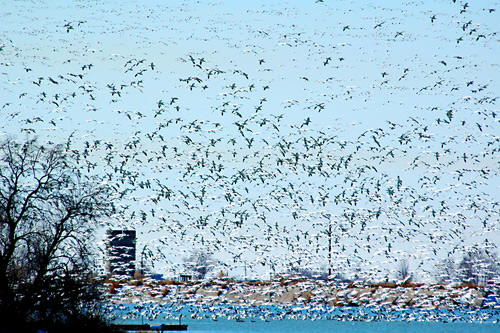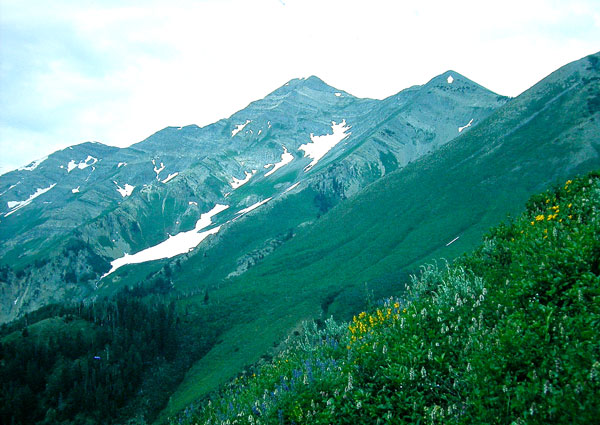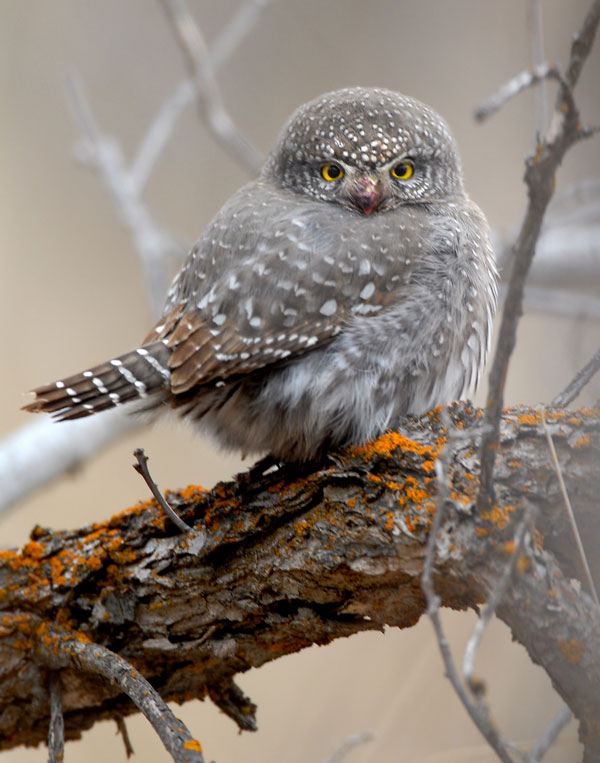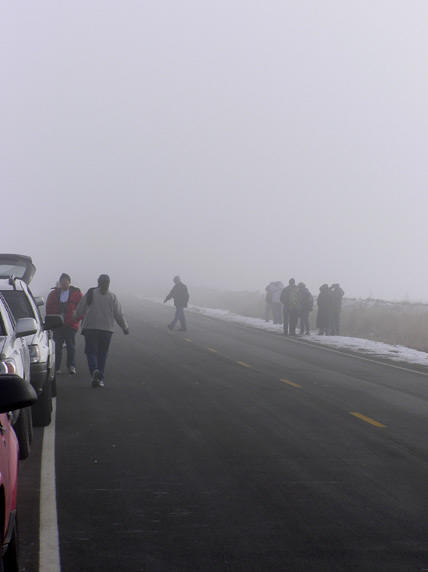Utah County Birders Newsletter
|
 |
|
Snow Geese at Gunnison Bend |
Gunnison Bend Reservoir (Millard County)
This reservoir is just west of Delta, Millard County, and can be accessed by driving south from Delta on US Highway 6 and taking the Sherwood Shores exit. Travel north to the reservoir. This isn’t exactly scenic area U.S.A., either, but during the Snow Goose festival in late winter it is a great place to watch the geese come in to land on the reservoir. There are usually blue phase Snow Geese as well, and sorting through all the Snow Geese to find the Ross’s Goose can be challenging and rewarding. To see and hear the thousands of beautiful, white geese as they descend on the reservoir is well worth the two hour trip from Provo.
Maple Canyon (Sanpete County)
I drove into this canyon quite by accident and am recommending it just because of its unique geological characteristics (and some interesting, though not necessarily great birds). Take the second Nephi exit off I-15 and drive east towards the towns of Fountain Green and Moroni. At the south end of Fountain Green you will see a road sign directing you to the town of Wales. Drive past the turn-off to Jerusalem (really) and continue south to Freedom, another small farming community. (If you haven’t been on this road before you probably had no idea there were Utah towns by these two names). At any rate, when you get to Freedom you will see a sign directing you to a forest service campground, or Maple Canyon. The drive to the canyon is less than five miles. As you drive into the canyon take note of the steep canyon walls. They are made of conglomerate. There is a small fee to access the campground. Walk around and take in the unusual geology. I have found both kinglets and both chickadees here as well as the Red-breasted Nuthatch, Brown Creeper and Canyon Wren.
Nebo Creek (Utah County)
South of Provo take the Price exit (#258) off I-15 and drive east up Spanish Fork Canyon on US Highway 6 to Thistle Junction. Turn off on Highway 89 and travel south. Just a couple of miles south of the Birdseye Church turn right (west) through a rancher’s gate, cross Thistle Creek and drive up Nebo Creek. The habitat here isn’t all that beautiful, but Nebo Creek has typical riparian vegetation of Narrow-leaf Poplar in the stream bottom with mixed pinion-juniper trees on the right of the road. Watch and listen for Yellow Warblers, Lazuli Buntings and Western Wood-Pewee. As you travel up the canyon you will cross through an old forest fire burn which killed the cottonwoods leaving dead skeletons of burned out trees which attract insects and Lewis’s Woodpeckers. After crossing the forest boundary in the same type of habitat and traveling on a bit farther, Page Fork is on the left. If the stream is low enough an attempt at crossing it by car will allow travel up a dirt road for about one and a half miles to the trail head. A mixture of birds such as Green-tailed Towhee, Warbling Vireo, Plumbeous Vireo, and Virginia’s Warblers can be observed in the oak-maple vegetation on the hillside. A one mile hike up the trail brings you to some conifers where you can find Pine Siskin and Red-breasted Nuthatch.
If you decide not to attempt the stream crossing at Page Fork continue on up the canyon for another mile or so. There is a mixture of cottonwood, pinion-juniper and oak-maple with associated species of jays, warblers and towhees.
Nebo Scenic Loop (Utah and Juab Counties)
 |
|
East Slope of Mount Nebo |
If you like driving through beautiful forested areas with vistas that reach out in every direction, this scenic loop is for you. In Payson drive south from the Peteetneet School to access this forest service road. The low riparian areas along the highway provide good habitat for Yellow-breasted Chat and Black-headed Grosbeak. There are various pull-out areas along the road as you travel up the canyon to the Payson Lakes area. Near the Payson Lakes exit stop and look for Lincoln’s Sparrows and MacGillivray’s Warblers in the willows. Watch for Purple Martins feeding over the lakes. The area near the junction to Blackhawk Campground has been a fairly consistent location to find Flammulated Owl at night. Stop at the Nebo Bench trail head and look for the Three-toed Woodpecker. This location has been one of the most reliable and consistent places to find this species in Utah County. All along this paved highway at higher elevations is good habitat for Mountain Bluebird. Plus, during the summer when the wildflowers are in bloom this makes for a beautiful drive. You can continue on southward and drop in elevation into Salt Creek Canyon, then drive until you access the main highway (#132). Turn right (west) and follow the road into Nephi.
[To be Continued - last 5 top
20 in next months newsletter]
 |
|
photo by Paul Higgins |
Northern Pygmy-Owl
Glaucidium gnoma
by Alona Huffaker
On December 10, 2007 I took some trash out to the garbage can and noticed
that there were a bunch of Black-capped Chickadees high up in the leafless Box
Elder trees just a chattering away. There were three Northern Flickers in the
same tree. "What’s going on?", I wondered, so I looked closer and there was a
little "grey lump" up there, too. I hurried in the house and called Bonnie
Williams next door and got my binoculars so I could examine the lump that was
attracting the attention of so many birds. I could tell it was a small owl that
was grey on top with a streaked belly. I walked around in the snowy backyard
until I could see it better. By then, Bonnie was out in her yard and I said
"Hey–there’s eyes in the back of it’s head". And she said, "Then it’s a Northern
Pygmy Owl!" Way cool for both of us–a new yard bird each! We watched it for a
few minutes, then it flew to the Maple tree in the front yard. When we found it
a few minutes later it had snagged an American Goldfinch and was busily eating
it!
Three weeks later it (or it’s cousin) was back in the same tree–near the same
spot, and stayed for about an hour and a half until a bunch of chickadees "drove
it crazy" and it flew away!
Our "Birds of Utah" checklist indicates the Northern Pygmy Owl as an uncommonly
seen, but permanent resident. The maps in several field guides show that it
lives in the western part of Canada and the U.S. and down in the central (east
to west) part of Mexico. It lives in wooded areas and perches high in the
canopy, although I have seen it perched on a telephone wire, too.
One of the best ways to spot this owl is to listen and to watch for "scolding
song birds" and to try to see what they are scolding at. According to Sibley,
Northern Pygmy Owls are "very aggressive, diurnal bird hunters, often attacking
birds much larger than they are–even as big as a mourning dove". They will also
eat mice and insects.
A number of years ago I learned from Lou Wilkinson that if you make the call
(who-who) of the Northern Pygmy Owl, other birds will come in to investigate.
Others in the club use this method, too–some with more success than others! Once
in Payson Canyon we used a tape and played this call and a number of birds came
in, including Black-capped Chickadees and Red-breasted Nuthatches! I’ve often
wondered why these birds come close to see where the "enemy" is? If you’re not
familiar with this sound, and have no access to tapes, go to whatbird.com. and
search for the Northern Pygmy Owl.
According to the Reader’s Digest Book of American Birds, the Northern Pygmy Owl
nests in a natural tree cavity or a woodpecker hole, laying 2-7 white eggs that
the female incubates for about 28 days. Both parents feed the young for another
four weeks.
My New Year’s wish for each of you is a Northern Pygmy Owl to mark on your
checklist, or how about your yard list!
Field Trip Report
Jordan River Parkway, Utah County - 12 Jan 2008
by Yvonne Carter
 |
|
UCB trying to see the Ferruginous Hawk
through the fog - 12 Jan 2008 |
Our field trip was led by the very well-experienced and enthusiastic Eric
Huish and started at the Park and Ride by the American Fork Main St. 1-15 exit
#278. The weather was mostly sunny, with blue skies but being at the lower
elevation close to waterways, we experienced some fog and mist, although
clearing at times. We started out just after 9 A.M. heading west on American
Fork's Main St. which becomes Lehi. Turning left at the T-intersection of 7500
West (Ut. Co.), we drove to the Spring Creek area, stopping to view birds plus a
bald eagle. Further west on 8170 No. (Ut. Co.) or Lehi's 7th South (I really
wish all of the townships would use Utah County coordinates) we arrived at the
Jordan River Parkway, parking by the model airplane field. After short walks,
identifying more birds along the river, we traveled slowly west along
agricultural fields to Redwood Road, turning north to Lehi's infamous Main St.
and east to Willow Park which is approximately 15th West and SR73. There we also
found a good selection of species, finishing just before noon.
On this field trip, we observed: Rock Pigeon, American Robin, Bald Eagle,
Northern Flicker, Starling, American Kestrel, Mourning Dove, Merlin, Red-Tailed
Hawk, Magpie, House Sparrow, Northern Harrier, Black-capped Chickadee, Mountain
Chickadee, Common Snipe, American Coots, Ring-Billed Gull, Canadian Geese,
Killdeer, Song Sparrow, White-crowned Sparrow, Raven, Prairie Falcon, Meadow
Lark, Spotted Towhee, Ferruginous Hawk, Rough-legged Hawk, Cedar Waxwing,
Ring-necked Pheasant, American Pipit, Red-winged Blackbird, Northern Shoveler
and
Great Blue Heron.
Those who participated in this winter morning excursion were: Steve Carlisle,
Merrill Webb, Pat Jividen, Yvonne Carter, Tuula Rose, Eric Huish, Bonnie
Williams, Alton Thygerson, Ned Bixler, Denise Metcalf, Bruce Robinson, Bill
Slater, Tom Williams, Matt Mills with his friend Stephanie, Larry Draper, Deloy
Pack, Alona Huffaker, Cheryl Peterson, Milt Moody, Junece Markham, and Flora
Duncan.
A successful field trip to start off the new year and a good start to our Utah
County Birders 2008 Birding Challenge!
Backyard Bird of the
Month
January 2008
Steve Carr - Holladay
Yellow-rumped Warbler - A pair of them enjoying the peanut butter.
Flora Duncan - Orem
Canada Goose - single goose flying over.
Lynn Garner - Provo
A first for our backyard: a Red-breasted Nuthatch.
Alona Huffaker - Springville
Northern Pygmy-Owl - See the 'Bird of the Month' column.
Eric Huish - Pleasant Grove
Northern Shrike - Yard lifer #90.
Junece Markham - Provo
Steller's Jay - I've had three coming in.
Carol Nelson - Provo
Eurasian Wigeon under my feeders, and Bohemian Waxwings in my flowering
pear.
LeIla Ogden - Orem
One Spotted Towhee comes daily to dine with all the finches and juncos.
Beautiful bird.
Cheryl Peterson - Provo
Sharp-shinned Hawk
Tuula Rose - Provo
A brief visit from a Brown Creeper made my day.
Alton Thygerson - Provo
Spotted Towhee - two coming to a feeder at the same time - fun to see
their nervous tails wag and how they scratch.
Barbara Watkins - I'm now a just-over-the-border Utah County Birder
Having finally moved into my new home, I've been excited to see what's in the
back yard. On the last day of January, a Golden Eagle was hunting in the
canyon during a windy snowstorm. He must have been very hungry.
Merrill Webb - Orem
Bohemian Waxwing - about 200 Bohemian and 40 Cedar in the waxwing Flock
Bonnie Williams - Mapleton
Northern Pygmy-Owl - Saw it FROM my yard but it was IN Alona's yard.
We would like you to share your favorite backyard bird each
month. Please send your favorite bird at the end of the month to newsletter@utahbirds.org
or call 360-8777.
The UCB Challenge has some new categories added.
Click here
to see the updated challenge categories.
If you’re going to buy a book through Amazon.com anyway, you can support our web site by entering Amazon.com through the link on our “Utah Birds” web site. That’s all you have to remember!
Thanks to all who have supported the web site in the past through your
purchases and also by participating in the hotlines, submitting “places to bird”
locations, submitting bird photos, offering suggestions and corrections as well
as paying your Utah County Birders dues which goes, in part, to pay for the web
hosting costs (which we get at the remarkable price of about $20 per month). If
you have any suggestions on how to improve the web site or the hotline listservs
please contact the webmaster (webmaster@utahbirds.org). Thank you for your support.
To try to save money we are going to stop mailing newsletters to people who haven't paid their dues. If you would like a paper version of the newsletter please make sure you have paid your dues. Check the address label on the front of your newsletter. It should read 'Thru-Jan 2009' in the upper right corner. If it doesn't and you have paid your dues please contact Carol Nelson (801-377-8208) or Eric Huish (newsletter@utahbirds.org - 801-360-8777) so we don't accidentally cut you off.
The current, and all past, UCB Newsletters can be found for free on the Web at http://www.utahbirds.org/newsletters/index.html. If you have paid your dues but prefer to read the newsletter on the web you can help the club save money by not receiving the paper version. Just let Eric Huish know that you only need the web version. He can send it right to your e-mail as soon as it becomes available.
We will be sending out a new Utah County Birders Membership List in
next months newsletter.
If you are a member you will be added to the list.
If you have been a member in the past you may be added to the list.
Please contact Eric at
newsletter@utahbirds.org or 801-360-8777 If...
If you have contact information we may not have (like e-mail), or you
have changed your phone, address or e-mail since last year.
If you do not wish to be on the list.
If you are not an official member but would like to be on the list. - (You do not have to be a UCB member to participate in UCB
Activities.)
If you have elected not to receive the paper version of the newsletter
and would like to have a copy of the UCB Membership list.
This list will not be posted on the web for the public.
Treat yourself or your valentine to a membership in the Utah County Birders.
A $15.00 membership pays for a handheld copy of the newsletter
and helps support the Utah Birds webpage.
Send checks made out to Utah County Birders to:
Carol Nelson
2831 Marrcrest West
Provo, Utah 84604